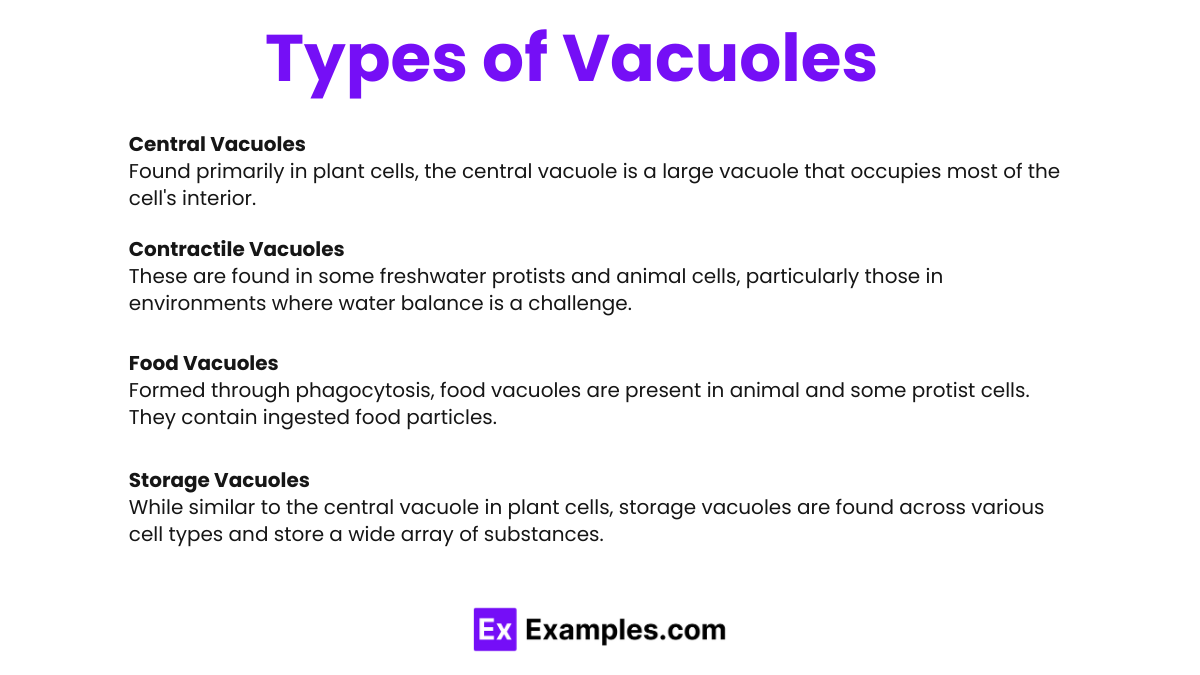Vacuoles
Dive into the essential world of vacuoles with our detailed guide, where we uncover their fascinating roles in cells across different organisms. Vacuoles, the versatile cellular compartments, are pivotal in nutrient storage, waste disposal, and maintaining osmotic balance within the cell. Through engaging examples, we illuminate how vacuoles adapt to different cellular needs, highlighting their significance in plant cells for water storage, and in animal cells for intracellular digestion and storage processes. Perfect for students and enthusiasts.
What is Vacuoles
Vacuoles are versatile, membrane-bound organelles predominantly found in plant and fungal cells, although they are also present in some animal and protist cells. Serving as cellular compartments, vacuoles perform a variety of essential functions that contribute to the growth, maintenance, and survival of cells. Their roles include isolating harmful materials, storing nutrients and waste products, maintaining internal hydrostatic pressure or turgor within the plant cell, and contributing to the degradation of cellular components.
Types of Vacuoles
Vacuoles can be broadly classified based on their function and the type of cell in which they are found. Understanding these types is essential for appreciating the diverse roles vacuoles play in cellular biology:
1. Central Vacuoles
Found primarily in plant cells, the central vacuole is a large vacuole that occupies most of the cell’s interior. It plays a pivotal role in maintaining turgor pressure against the cell wall, enabling the plant to maintain its shape and size. It also stores nutrients, waste products, and contributes to cell elongation by absorbing water and enlarging.
2. Contractile Vacuoles
These are found in some freshwater protists and animal cells, particularly those in environments where water balance is a challenge. Contractile vacuoles help expel excess water out of the cell, thereby maintaining osmotic pressure and preventing the cell from bursting due to overhydration.
3. Food Vacuoles
Formed through phagocytosis, food vacuoles are present in animal and some protist cells. They contain ingested food particles and fuse with lysosomes, whose digestive enzymes break down the food into nutrients that can be absorbed by the cell.
4. Storage Vacuoles
While similar to the central vacuole in plant cells, storage vacuoles are found across various cell types and store a wide array of substances, including proteins, pigments, and waste products. Their composition varies depending on the cell type and the organism’s environmental needs.
Structure of Vacuoles
Vacuoles are membrane-bound organelles present in the cells of plants, fungi, and certain protists and animals, though their size, number, and function can vary significantly among different organisms. In plant cells, vacuoles are particularly large and can occupy more than 80% of the cell’s volume, whereas in animal and fungal cells, they tend to be smaller and more numerous.
The structure of a vacuole consists of a single membrane called the tonoplast, which encloses the vacuolar contents. This membrane is selectively permeable, allowing the passage of certain solutes while maintaining the concentration and pH levels inside the vacuole.
Functions of Vacuoles
Vacuoles serve multiple functions within cells, depending on the cell type and organism. Some of the primary functions include:
- Storage: Vacuoles act as storage areas for essential nutrients, ions, and water. In plants, vacuoles store amino acids, sugars, and sometimes toxic substances to deter herbivory. In seeds, vacuoles store proteins and lipids necessary for germination.
- Waste Disposal: Vacuoles can contain enzymes that break down macromolecules, making them akin to lysosomes in animal cells. They help in the degradation and recycling of cellular waste and toxic substances.
- Turgor Pressure and Plant Rigidity: In plant cells, vacuoles maintain turgor pressure, which is the pressure of the cell contents against the cell wall. This pressure keeps plants upright and is crucial for plant growth and the movement of leaves and flowers.
- pH and Ionic Homeostasis: Vacuoles help in regulating the pH and ionic balance within the cell. By sequestering or releasing ions, vacuoles maintain cellular homeostasis and contribute to various metabolic processes.
- Defense: Some vacuoles contain toxic substances or digestive enzymes that protect the plant against herbivores and pathogens. When an herbivore attacks a plant, these compounds can be released, deterring further damage.
- Germination: In seeds, vacuoles play a critical role during germination by releasing stored nutrients to support the growth of the young plant.
FAQS
Why do plant cells have larger vacuoles?
Plant cells have larger vacuoles to store water and maintain turgor pressure, essential for plant rigidity and growth.
Why are vacuoles an important cell organelle?
Vacuoles are crucial for storing nutrients, disposing of waste, and maintaining internal cellular environment and pressure balance.
Vacuoles play a vital role in cellular maintenance, acting as storage centers for essential nutrients and waste products. They regulate turgor pressure in plant cells, contributing to structural support, and are involved in intracellular digestion and the release of cellular waste. Understanding vacuoles’ functions highlights their significance in cell health, growth, and adaptation to environmental changes, underscoring their importance in biological processes.



